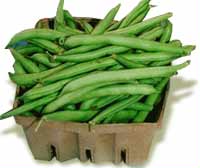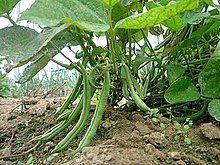Green bean
This is Wikipedia's current article for improvement – and you can help edit it! You can discuss how to improve it on its talk page and ask questions at the help desk or Teahouse. See the cheatsheet, tutorial, editing help and FAQ for additional information. Editors are encouraged to create a Wikipedia account and place this article on their watchlist.
Find sources: "Green bean" – news · newspapers · books · scholar · JSTOR |
You can help expand this article with text translated from the corresponding article in French. (February 2018) Click [show] for important translation instructions.
|


Green beans are the unripe, young fruit and protective pods of various cultivars of the common bean (Phaseolus vulgaris).[1][2] Immature or young pods of the runner bean (Phaseolus coccineus), yardlong bean (Vigna unguiculata subsp. sesquipedalis), and hyacinth bean (Lablab purpureus) are used in a similar way.[3] Green beans are known by many common names, including French beans,[4] string beans,[4] snap beans,[4] and snaps.[5][6]
They are distinguished from the many differing varieties of beans in that green beans are harvested and consumed with their enclosing pods, typically before the seeds inside have fully matured. This practice is analogous to the harvesting of unripened pea pods as snow peas or sugar snap peas.
Nutrition and culinary use
| Nutritional value per 100 g (3.5 oz) | |||||||||||||||||||||||||||||||||||||||||||||
|---|---|---|---|---|---|---|---|---|---|---|---|---|---|---|---|---|---|---|---|---|---|---|---|---|---|---|---|---|---|---|---|---|---|---|---|---|---|---|---|---|---|---|---|---|---|
| Energy | 131 kJ (31 kcal) | ||||||||||||||||||||||||||||||||||||||||||||
6.97 g | |||||||||||||||||||||||||||||||||||||||||||||
| Dietary fiber | 2.7 g | ||||||||||||||||||||||||||||||||||||||||||||
0.22 g | |||||||||||||||||||||||||||||||||||||||||||||
1.83 g | |||||||||||||||||||||||||||||||||||||||||||||
| |||||||||||||||||||||||||||||||||||||||||||||
| Other constituents | Quantity | ||||||||||||||||||||||||||||||||||||||||||||
| Fluoride | 19 µg | ||||||||||||||||||||||||||||||||||||||||||||
| †Percentages estimated using US recommendations for adults,[7] except for potassium, which is estimated based on expert recommendation from the National Academies.[8] | |||||||||||||||||||||||||||||||||||||||||||||

In the past, bean pods often contained a "string", a hard fibrous strand running the length of the pod. This was removed before cooking, or made edible by cutting the pod into short segments. Modern, commercially grown green bean varieties lack strings.
Green beans are eaten around the world, and are marketed canned, frozen, and fresh. Green beans are often steamed, boiled, stir-fried, or baked in casseroles. A dish with green beans popular throughout the United States, particularly at Thanksgiving, is green bean casserole, which consists of green beans, cream of mushroom soup, and French fried onions.[9]
Some US restaurants serve green beans that are battered and fried, and some Japanese restaurants serve green bean tempura. Green beans are also sold dried, and fried with vegetables such as carrots, corn, and peas, as vegetable chips.
The flavonol miquelianin (Quercetin 3-O-glucuronide) can be found in green beans.[10]
Characteristics
The first "stringless" bean was bred in 1894 by Calvin Keeney, called the "father of the stringless bean", while working in Le Roy, New York.[11] Most modern green bean varieties do not have strings.[3]
Plant
Green beans are classified by growth habit into two major groups, "bush" (or "dwarf") beans and "pole" (or "climbing") beans.[12][13][14]
- Bush beans are short plants, growing to not more than 2 feet (61 cm) in height, often without requiring supports. They generally reach maturity and produce all of their fruit in a relatively short period of time, then cease to produce. Due to this concentrated production and ease of mechanized harvesting, bush-type beans are those most often grown on commercial farms. Bush green beans are usually cultivars of the common bean (Phaseolus vulgaris).
- Pole beans have a climbing habit and produce a twisting vine, which must be supported by "poles", trellises, or other means. Pole beans may be common beans (Phaseolus vulgaris), runner beans (Phaseolus coccineus) or yardlong beans (Vigna unguiculata subsp. sesquipedalis).[15][16]
Varieties
Over 130 varieties of green bean are known.[17] Varieties specialized for use as green beans, selected for the succulence and flavor of their pods, are the ones usually grown in the home vegetable garden, and many varieties exist. Pod color can be green, purple, red, or streaked[18]. Shapes range from thin "fillet" types to wide "romano" types and more common types in between. Yellow-podded green beans are also known as wax beans.[3]
All of the following varieties have green pods and are Phaseolus vulgaris, unless otherwise specified:
Bush (dwarf) types
- Blue Lake 274[2]
- Bush Kentucky Wonder[2]
- Derby (1990 AAS winner)[2]
- Kenyan Bean[14]
- Purple Teepee (purple pods)[14]
Pole (climbing) types
- Algarve[14]
- Blue Lake[2]
- Golden Gate (yellow/wax)[14]
- Kentucky Blue (AAS Winner)[2]
- Kentucky Wonder[2]
- Scarlet Runner (Phaseolus coccineus)[19]
Production
According to UN Food and Agriculture Organization (FAOSTAT), the top producers of green beans (in metric tonnes) in 2012.[20]
| Rank | Country | Production (t) |
|---|---|---|
| 1 | 16,200,000 | |
| 2 | 871,170 | |
| 3 | 620,000 | |
| 4 | 614,960 | |
| 5 | 305,000 | |
| 6 | 251,279 | |
| 7 | 165,400 | |
| 8 | 134,124 | |
| 9 | 133,744 | |
| 10 | 94,356 | |
| World | 20,742,857 |
References
- ^ "Green Beans". The World's Healthiest Foods. Retrieved March 2, 2017.
- ^ a b c d e f g "Beans – Vegetable Directory – Watch Your Garden Grow – University of Illinois Extension".
- ^ a b c "Growing beans in Minnesota home gardens". University of Minnesota Agricultural Extension. Retrieved 20 September 2016.
- ^ a b c Green, Aliza. Field Guide to Produce. p. 126.
- ^ Singh BK and Singh B. 2015. Breeding perspectives of snap bean (Phaseolus vulgaris L.). Vegetable Science 42(1): 1-17.
- ^ Hatch, Peter J. "A Rich Spot of Earth": Thomas Jefferson's Revolutionary Garden at Monticello. pp. 159–161.
- ^ United States Food and Drug Administration (2024). "Daily Value on the Nutrition and Supplement Facts Labels". FDA. Archived from the original on 2024-03-27. Retrieved 2024-03-28.
- ^ National Academies of Sciences, Engineering, and Medicine; Health and Medicine Division; Food and Nutrition Board; Committee to Review the Dietary Reference Intakes for Sodium and Potassium (2019). Oria, Maria; Harrison, Meghan; Stallings, Virginia A. (eds.). Dietary Reference Intakes for Sodium and Potassium. The National Academies Collection: Reports funded by National Institutes of Health. Washington, DC: National Academies Press (US). ISBN 978-0-309-48834-1. PMID 30844154. Archived from the original on 2024-05-09. Retrieved 2024-06-21.
- ^ Cook's Illustrated (2004). The New Best Recipe. America's Test Kitchen.
- ^ Antioxidant properties of flavonol glycosides from green beans. Plumb G.W., Price K.R. and Williamson G., Redox Report, Volume 4, Number 3, June 1999, pages 123-127, doi:10.1179/135100099101534800
- ^ Taylor's guide to heirloom vegetables. Boston: Houghton Mifflin. 1996. ISBN 0-395-70818-4.
- ^ McGee, Rose Marie Nichols; Stuckey, Maggie (2002). The Bountiful Container. Workman Publishing.
- ^ Garrelts, C.; Garrelts, Megan; Lee, Bonjwing (2011). Bluestem: The Cookbook. Andrews McMeel Publishing. p. 71. ISBN 978-1-4494-0061-3.
- ^ a b c d e How to Grow French Beans – Royal Horticultural Society, RHS Gardening
- ^ Capomolla, F. (2017). Growing Food the Italian Way. Pan Macmillan Australia. p. 143. ISBN 978-1-76055-490-3. Retrieved February 26, 2018.
- ^ Watson, B. (1996). Taylor's Guide to Heirloom Vegetables. TAYLOR'S WEEKEND GARDENING GUIDES. Houghton Mifflin. p. 238. ISBN 978-0-395-70818-7. Retrieved February 26, 2018.
- ^ Facciola, Stephen (1998). Cornucopia II : a source book of edible plants. Kampong Publications. ISBN 0-9628087-2-5.
- ^ Singh B K, Pathak K A, Ramakrishna Y, Verma V K and Deka B C. 2011. Purple-podded French bean with high antioxidant content. ICAR News: A Science and Technology Newsletter 17 (3): 9.
- ^ Runner beans are beautiful and edible – Oregon State University Agricultural Extension
- ^ "Production of Green Bean by countries". UN Food and Agriculture Organization. 2011. Archived from the original on 2011-07-13. Retrieved 2015-02-02.
{{cite web}}: Unknown parameter|deadurl=ignored (|url-status=suggested) (help)
External links
 Media related to Green beans at Wikimedia Commons
Media related to Green beans at Wikimedia Commons- Green beans at United States Department of Agriculture
